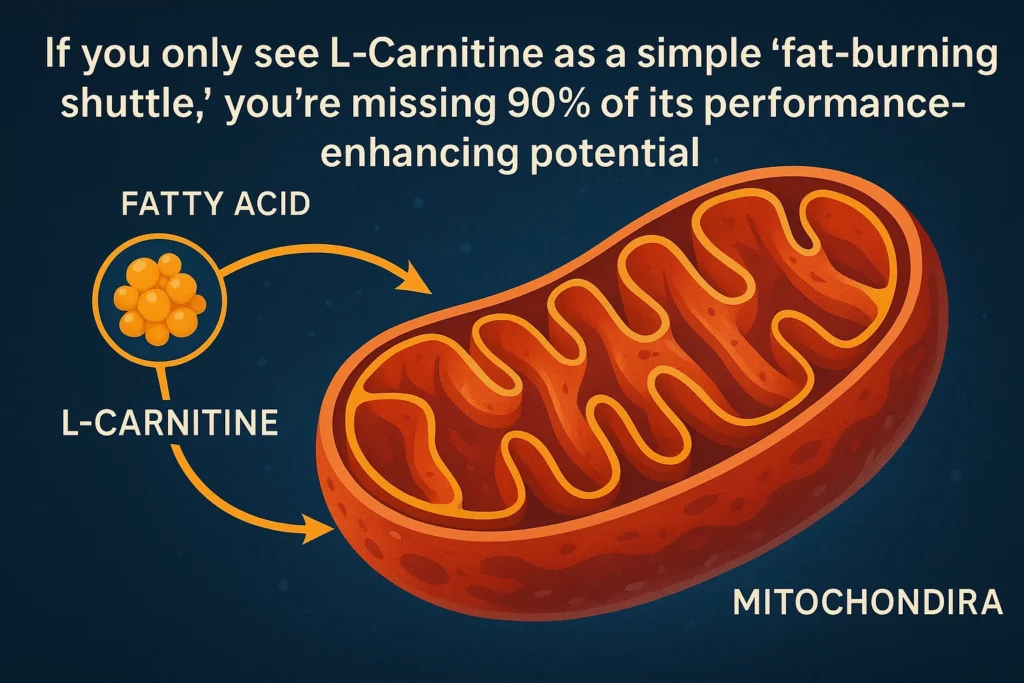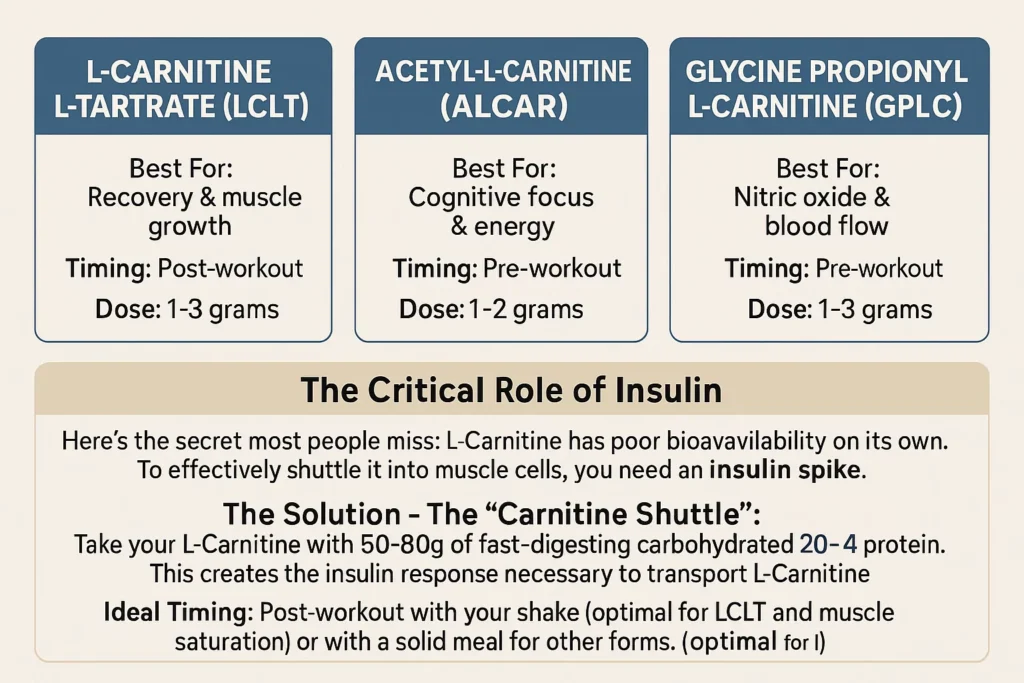The Misunderstood Molecule
If you only see L-Carnitine as a simple ‘fat-burning shuttle,’ you’re missing 90% of its performance-enhancing potential. For decades, this supplement has been pigeonholed as a weight loss aid, but emerging research reveals its true value lies in recovery, performance optimization, and metabolic regulation. It’s time to upgrade your understanding of this cellular powerhouse.
What Exactly Is L-Carnitine? The Cellular Chauffeur
L-Carnitine is a naturally occurring compound synthesized from the amino acids lysine and methionine. Think of it less as a supplement and more as an essential metabolic traffic controller within your cells.
Its primary, non-negotiable job is transporting long-chain fatty acids into the mitochondria—the power plants of your cells—where they can be converted into usable energy through a process called beta-oxidation. This is why it’s often associated with fat burning, but that’s just the beginning of the story.
Key Insight: L-Carnitine isn’t a “fat burner” in the traditional sense—it’s a “fat utilization enabler.” Without adequate L-Carnitine, your body struggles to efficiently convert stored fat into energy, regardless of how hard you’re training.
Beyond the Hype: Debunking the “Fat Burner” Myth
Let’s address the elephant in the room: if L-Carnitine is so crucial for fat metabolism, why doesn’t supplementing with it always lead to dramatic fat loss?
The answer lies in understanding metabolic bottlenecks. For most healthy individuals with adequate L-Carnitine levels, simply adding more doesn’t automatically accelerate fat burning. The activity of enzymes within the mitochondria often becomes the rate-limiting factor, not the availability of L-Carnitine itself.
Additionally, muscle tissue in well-nourished athletes is typically already saturated with L-Carnitine. Adding more is like adding more Uber drivers to a city that already has enough—it doesn’t necessarily get people to their destinations faster.
The Real Body Composition Benefit: L-Carnitine’s true value for physique athletes comes from its secondary effects—enhanced recovery and increased workout capacity—which allow for more volume and intensity over time, leading to better body composition indirectly.
The Athlete’s Edge: L-Carnitine’s Underrated Performance Benefits
1. The Ultimate Recovery Tool: Reducing Metabolic Waste
During intense exercise, your muscles accumulate metabolic byproducts like acetyl-CoA. L-Carnitine helps buffer these compounds, improving the acetyl-CoA/CoA-SH ratio. This enhances oxidative energy metabolism and reduces fatigue-inducing metabolites.
Practical Impact: Less muscle burn and lactate accumulation during high-intensity sets, enabling better performance in later sets and subsequent training sessions. This means you can maintain higher quality volume throughout your workout and recover faster between sessions.
2. The Anabolic Signal Booster: Enhancing Androgen Receptor Density
This might be L-Carnitine’s most exciting benefit for bodybuilders. Research published in reputable journals like the Journal of Physiology has demonstrated that L-Carnitine supplementation can increase androgen receptor density in muscle cells.
The “Key and Lock” Analogy: Think of testosterone as keys and androgen receptors as locks. More receptors (locks) mean your body’s natural testosterone (keys) has more places to bind, potentially enhancing muscle growth and strength signals. For natural athletes, this is a game-changing mechanism that can maximize your hormonal environment.
3. The Blood Flow Optimizer: Supporting the “Pump”
Certain forms of L-Carnitine (particularly Glycine Propionyl L-Carnitine) have been shown to increase nitric oxide synthase activity, leading to improved vasodilation.
Practical Result: Better nutrient delivery to working muscles, a superior muscle pump during training, and potentially reduced perceived exertion. The improved blood flow also enhances waste product removal from muscle tissue, further supporting recovery.
The Practical Dosing Protocol: Timing, Form, and Synergy
Choosing the Right Form
L-Carnitine L-Tartrate (LCLT)
Best For: Recovery & muscle growth
Timing: Post-workout
Dose: 1-3 grams
Acetyl-L-Carnitine (ALCAR)
Best For: Cognitive focus & energy
Timing: Pre-workout or morning
Dose: 1-2 grams
Glycine Propionyl L-Carnitine (GPLC)
Best For: Nitric oxide & blood flow
Timing: Pre-workout
Dose: 1-3 grams
The Critical Role of Insulin
Here’s the secret most people miss: L-Carnitine has poor bioavailability on its own. To effectively shuttle it into muscle cells, you need an insulin spike.
The Solution – The “Carnitine Shuttle”: Take your L-Carnitine with 50-80g of fast-digesting carbohydrates and 20-40g of protein. This creates the insulin response necessary to transport L-Carnitine into muscle tissue where it’s needed most.
Ideal Timing: Post-workout with your shake (optimal for LCLT and muscle saturation) or with a solid meal for other forms. According to the National Institutes of Health, this strategy can increase muscle uptake by up to 300% compared to taking L-Carnitine alone.
Food vs. Supplements: Can You Get Enough from Your Diet?
L-Carnitine is naturally found in animal products, with the highest concentrations in red meat (especially beef), poultry, fish, and dairy. A typical omnivorous diet provides about 100-300mg daily.
However, athletes face a unique challenge: intense training increases demand and utilization. The American College of Sports Medicine notes that endurance athletes may have 20-30% lower muscle carnitine levels after prolonged training. For vegans and vegetarians, who consume minimal pre-formed L-Carnitine, supplementation becomes particularly important.
Conclusion: Stop Calling It a Fat Burner
L-Carnitine’s true value lies in its synergistic benefits: accelerated recovery, enhanced anabolic signaling, and improved workout performance. When used strategically with proper nutritional co-factors, it transitions from a misunderstood fat-loss supplement to a foundational metabolic optimizer.
For bodybuilders and athletes chasing peak performance, L-Carnitine isn’t about finding a shortcut—it’s about optimizing the complex biochemical processes that translate hard work into measurable results. Stop calling it a fat burner and start leveraging it as the recovery and performance enhancer it truly is.




